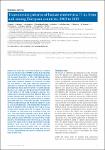Transmission patterns of human enterovirus 71 to, from and among European countries, 2003 to 2013
Hassel, C.
Mirand, A.
Lukashev, A.
Terletskaia-Ladwig, E.
Farkas, A.
Schuffenecker, I.
Diedrich, Sabine
Huemer, H. P.
Archimbaud, C.
Peigue-Lafeuille, H.
Henquell, C.
Bailly, J.
Enterovirus 71 (EV-71) is involved in epidemics of hand, foot, and mouth disease (HFMD) and has been reported to occur with severe neurological complications in eastern and south-east Asia. In other geographical areas, the transmission of this virus is poorly understood. We used large sequence datasets (of the gene encoding the viral protein 1, VP1) and a Bayesian phylogenetic approach to compare the molecular epidemiology and geographical spread patterns of EV-71 subgenogroups B4, B5, C1, C2, and C4 in Europe relative to other parts of the world. For the study, European countries considered were European Union (EU) Member States and Iceland, Norway and Switzerland. Viruses of the B4, B5, and C4 subgenogroups circulate mainly in eastern and south-east Asia. In Europe sporadic introductions of these subgenogroups are observed, however C1 and C2 viruses predominate. The phylogenies showed evidence of multiple events of spread involving C1 and C2 viruses within Europe since the mid-1990s. Two waves of sporadic C2 infections also occurred in 2010 and 2013. The 2007 Dutch outbreak caused by C2 and the occurrence of B5 and C4 infections in the EU between 2004 and 2013 arose while the circulation of C1 viruses was low. A transmission chain involving a C4 virus was traced from Japan to the EU and then further to Canada between 2001 and 2006. Recent events whereby spread of viruses have occurred from, to, and within Europe appear to be involved in the long term survival of EV-71, highlighting the need for enhanced surveillance of this virus.
Dateien zu dieser Publikation
Keine Lizenzangabe
Verwandte Publikationen
Anzeige der Publikationen mit ähnlichem Titel, Autor, Urheber und Thema.
-
2015-05-01ZeitschriftenartikelLow-level Circulation of Enterovirus D68–Associated Acute Respiratory Infections, Germany, 2014 Reiche, Janine; Böttcher, Sindy; Diedrich, Sabine; Buchholz, Udo; Buda, Silke; Haas, Walter; Schweiger, Brunhilde; Wolff, ThorstenWe used physician sentinel surveillance to identify 25 (7.7%) mild to severe infections with enterovirus D68 (EV-D68) in children and adults among 325 outpatients with acute respiratory infections in Germany during ...
-
2001-09-14ZeitschriftenartikelAseptic meningitis in Germany associated with echovirus type 13 Diedrich, Sabine; Schreier, EckartBackground: Echoviruses are the commonest cause of aseptic meningitis. Echovirus type 13 which has not been isolated in Germany over a long period of time was the predominant enterovirus serotype associated with different ...
-
2015-08-13ZeitschriftenartikelAge-related prevalence of cross-reactive antibodies against influenza A(H3N2) variant virus, Germany, 2003 to 2010 Blümel, Benjamin; Schweiger, Brunhilde; Dehnert, Manuel; Buda, Silke; Reuss, Annicka; Czogiel, Irina; Kamtsiuris, Panagiotis; Schlaud, Martin; Poethko-Müller, Christina; Thamm, Michael; Haas, WalterTo estimate susceptibility to the swine-origin influenza A(H3N2) variant virus (A(H3N2)v) in the German population, we investigated cross-reactive antibodies against this virus and factors associated with seroprotective ...

